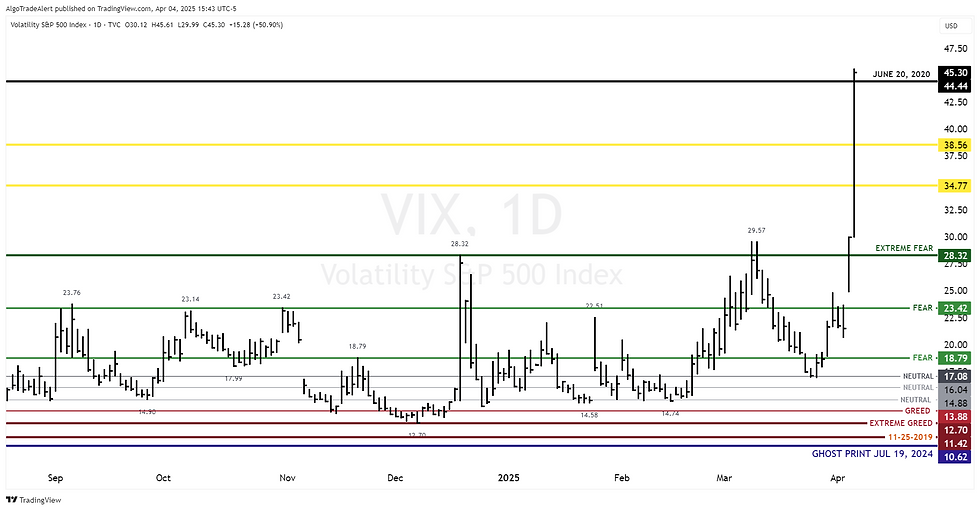Stock Market Update Friday April 4, 2025
- AlgoTradeAlert
- 10 hours ago
- 4 min read
Stock Market Update Friday April 4, 2025 Markets In Turmoil Free Edition
Premium Market Recap – April 4, 2025
**Stocks Under Pressure:** Stock prices continued to fall because Federal Reserve Chair Jerome Powell indicated the Fed wasn't in a hurry to cut interest rates. This caused the stock market to decline further. Early in the day, the S&P 500 dropped by another 4.5%, and options market data suggested a possible 3% move when the market opened on Monday, implying high volatility was expected. By the end of the trading day, the S&P 500 had fallen by 6%, while the Nasdaq 100 (QQQ) also fell by 6% and the Russell 2000 (IWM, which represents small-cap companies) decreased by 4.5%. This shows that stocks across various sectors and sizes experienced broad selling pressure.
**Away From Stocks** Despite Powell's strong message, the bond market seemed unconvinced. The 2-year Treasury yield, which is very sensitive to changes in Fed policy, fell by another 10 basis points to 3.62%. This followed a 20 basis-point drop on Thursday. This suggests that investors are increasingly anticipating a policy mistake by the Fed or future economic problems.
In the commodities market, West Texas Intermediate (WTI) crude oil fell below $62 per barrel, which is considered a significant psychological level. Gold prices decreased to $3,030 per ounce, indicating a slight decrease in demand for safe-haven assets. Interestingly, Bitcoin showed considerable strength, trading above $83,000, highlighting its growing role as an alternative asset during times of economic uncertainty. Meanwhile, the VIX (a measure of market volatility) remained high, above 40, after briefly rising to 45 during the day, which shows continued market nervousness and hedging activity.
**Geopolitical & Trade Tensions:** Investor confidence was also negatively affected by stalled trade talks and increasing geopolitical tensions. China has responded to U.S. actions by announcing a 34% tariff on certain U.S. imports, effective April 10, and by restricting exports of rare earth minerals, which are crucial for high-tech and defense industries. In the agricultural sector, Chinese customs officials have immediately banned sorghum imports from C&D (USA) Inc., as well as poultry and bonemeal from three other U.S. companies, further worsening the trade situation.
**Investor Sentiment:** The latest American Association of Individual Investors (AAII) sentiment survey reveals a pessimistic outlook: 61.9% of respondents are bearish (expecting the market to decline), which is the third-highest bearish reading in the survey's history, exceeded only by the lows of March 2009 and October 1990. Bullish sentiment (expecting the market to rise) has dropped to 21.8%, nearing historic lows. However, this high level of bearishness, while often seen as a sign that the market might reverse, has not yet triggered the type of extreme selling (capitulation) that usually precedes a market turnaround. Without such a capitulation or a significant decrease in selling pressure, the market may struggle to stabilize.
**Key Dates Ahead:** All eyes are on the deadlines of April 5th and April 9th, as Europe and China are expected to respond to the U.S. tariff proposals. Successful negotiations could ease fears of a full-blown trade war, while failure to reach agreements may lead to another sharp decline in stock prices.
Bottom Line:
Our proprietary trading algorithm has triggered sell signals across all five major U.S. equity benchmarks: SPY, RSP, QQQ, IWM, and DIA ETFs. The corresponding signal dates are detailed below and visualized on the accompanying charts.
We view this week's market correction as a transitory pullback, rather than the start of a sustained downturn. Current signals out of Washington suggest that the imposition of new tariffs is more likely a short-term bargaining instrument within ongoing trade negotiations, rather than a definitive shift toward structural protectionism or economic decoupling.
This distinction is critical for investors assessing the duration and depth of geopolitical risk pricing into the equity markets. Weekend developments—particularly trade talks and policy announcements from April 5th and April 9th—will likely serve as inflection points for near-term price action.
Given the elevated uncertainty and lack of a confirmed buy signal from our model, we strongly advise against initiating new long positions or adding exposure at this time. Once our algorithm generates a buy confirmation, we will look to reallocate capital into existing or new sector-specific positions accordingly.
March 19, 2025 Algorithmic Sell Signals & Market Trends March 3, 2025 – Sell alert triggered for S&P 500 Equal Weight RSP ETF, bringing the total to five major indexes on sell alerts. February 24, 2025 – Sell signal issued for Russell 2000 IWM ETF, confirmed by a prior weekly chart sell alert on February 21. February 24, 2025 – Dow Jones Industrial Average ETF (DIA) moved to sell condition.
W.D. Gann Cycle Pivot Date for the S&P 500 (SPX) on Saturday, April 5, 2025. Historically, these cycle dates often coincide with significant inflection points in price action. While the market will be closed on Saturday, we will be watching for a potential pivot either into Friday’s close or by Monday’s session.









